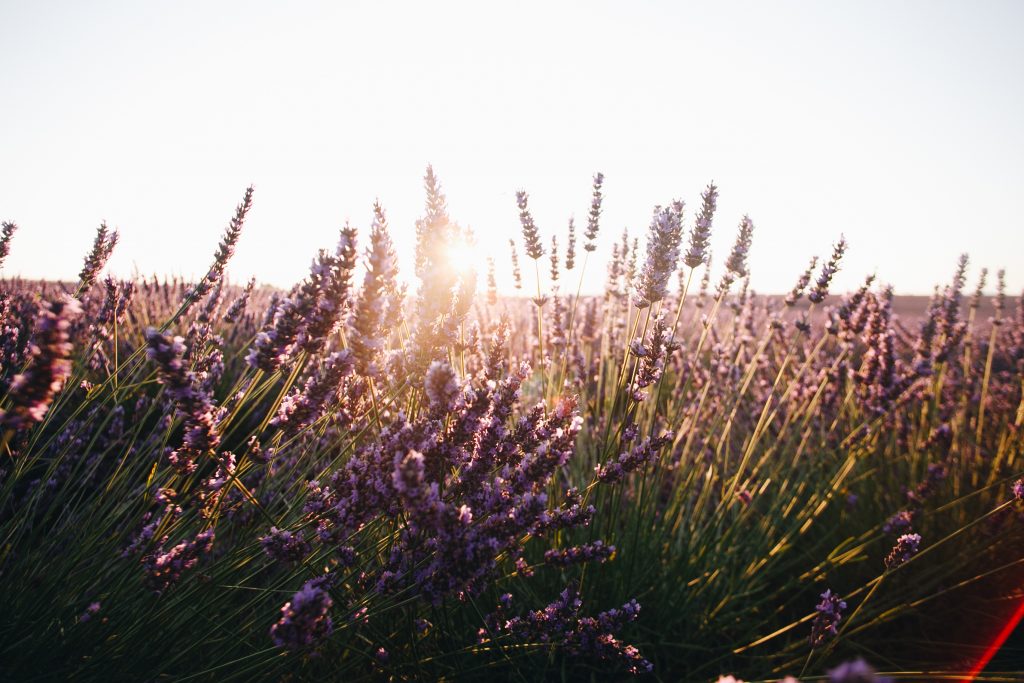Growing lavender for profit on your farm can be a lucrative undertaking.
In addition to being a high-value crop, lavender is also low maintenance. It’s a perennial plant that will continue producing year after year. While it might not be quite as easy to grow as microgreens or salad mix, we think it’s a good next step for the beginner farmer or gardener.
As with any crop, there is a learning curve when growing lavender for the first time. So, we’ve put together a guide to help. Let’s start with the basics:
What is Lavender?
Lavender is an herb that’s in the same family as mint and sage.
It originates from the Mediterranean, but today lavender is grown all around the world, from Europe and North America to parts of Africa and Asia.
Lavender is traditionally used as a culinary herb as well as an ingredient in cosmetics and medicine. It’s also used to produce essential oils and as an ornamental plant for landscaping.
Reasons to Grow Lavender
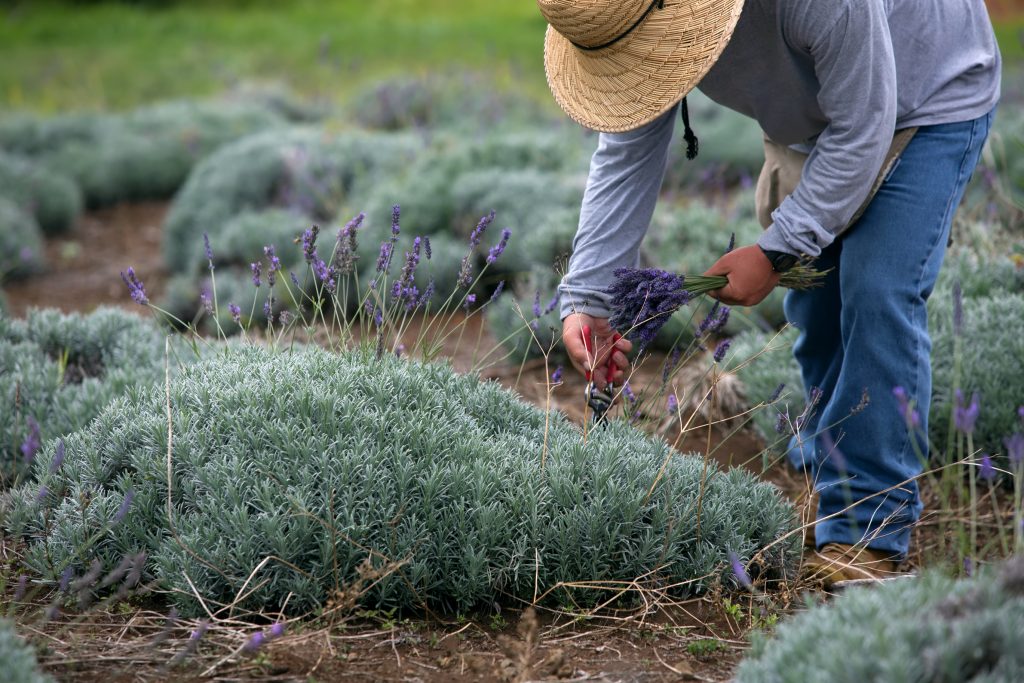
Here are a few good reasons to add lavender to your farm or garden.
1. There’s Demand for It
Is there a demand for lavender? Absolutely!
In fact, the demand for lavender currently outpaces the supply. That means you should have no problem selling as much lavender as you can grow.
Plus, market studies indicate that demand for lavender is expected to increase in the long-term.
2. It’s Profitable
How profitable is growing lavender?
Modern Farmer lists lavender as one of the five most valuable crops you can grow in the US. (For more information on the most lucrative crops, check out our own article on the Top 13 Most Profitable Crops to Grow.)
Compared to standard crops like corn or soybeans that typically generate less than $1,000 per acre, the choice is obvious. An efficient lavender operation can produce 100 times that much money in the same amount of space!
3. It’s Easy to Grow
Lavender is a relatively low-maintenance crop. It needs a lot of sun and well-drained soil. However, it doesn’t usually require fertilizer or a lot of water.
You can plant lavender along with other plants without any issues. Its large bushes can also be used as hedges and windbreaks.
4. It Attracts Beneficial Insects
Bees, butterflies and other beneficial insects all love lavender when it’s in bloom.
As bee populations decline, you want to attract as many pollinators to your garden as you can, so lavender is a great choice.
5. It Repels Bad Insects
Lavender doesn’t just attract good bugs. It also keeps the bad ones at bay.
Mosquitos, moths, ticks, fleas and flies all dislike the smell of lavender. Growing it will help you to enjoy the outdoors without the annoying pests.
6. You Can Make a Wide Variety of Products From It
You can sell lavender on its own, either fresh or dried. But if you’re willing to put in a little extra work, you can also use your lavender to create a wide variety of products.
Some lavender products to consider include crafts, bath and body products, food and drink and cleaning or home products.
Some of these items can sell for as much as 500% more than simply selling raw lavender.
The Correct Climate for Growing Lavender
While lavender is easy to grow in the right area, it can’t grow everywhere. It’s all about location.
Lavender does best in a Medditeranean climate. Although it can be grown in other climates as well, it will grow best in zones 5 to 9.
Since lavender needs well-draining soil, it won’t do well in areas with heavy clay. You’ll want to grow it in either sandy or sandy loam soil. Alternatively, it can be grown on a slope so that water quickly drains away from the plant’s roots.
High humidity can be a problem for lavender because it leads to fungal diseases. Sometimes you can correct this by planting your lavender further apart for better air circulation. However, if you live in a location with very humid summers, lavender may not be the best crop for you to grow.
Lavender and Agrotourism
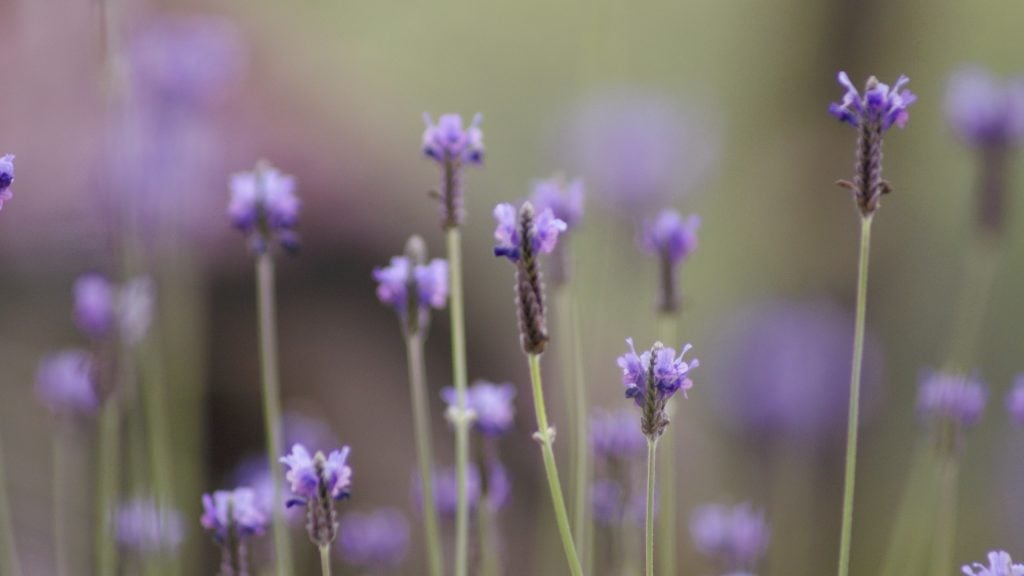
Many farmers make money growing lavender by participating in agri-tourism. If you’re interested in having guests visit your lavender field, you’ll want your farm to be easily accessible and located where a lot of people drive by it. (It may be hard to get people to visit if you’re tucked away off the main highway.)
The Best Lavender Species to Grow
You might be surprised to learn that there isn’t just one variety of lavender. In fact, there are over 30 lavender varieties to choose from. That said, most commercial growers choose from just a handful of options.
Depending on what you plan to do with your lavender, different species will have attributes that are better suited for different uses. For example, some lavender tastes best for cooking while another species may look best for flower arrangements.
English Lavender
English lavender is by far the most popular species of lavender to grow.
It does best with mild summers and it’s cold-hardy enough to survive cold winters.
This species has the most versatile range of applications. You can use it for cooking, fragrances, dried flowers, essential oils and more.
French Lavender
This species of lavender does best in temperate or warm regions. Its fragrance is more mild than English lavender and other lavender varieties and its flowers are a purple-blue color.
Spanish Lavender
If you’re looking to grow lavender as an annual instead of a perennial, Spanish lavender is the species for you.
This species is more compact than other species and is typically used for ornamental purposes. It can either be added to bouquets fresh or as a dried flower.
Spanish lavender blooms earlier than other lavender varieties and continues to bloom for the longest period of time. However it’s also the least hardy and won’t do as well in colder climates.
Hybrid Lavender
Some lavender growers have experimented with growing their own new species of lavender. These are crosses between existing popular lavender varieties and often attempt to combine the best traits of both.
Hybrid lavender plants are sterile and their seeds are not viable, so they can only be grown from cuttings. The hybrid plants are sometimes referred to as spike lavender.
Depending on what you’re growing lavender for, there are many hybrids to choose from. Some seek to maximize oil production, while others dry better for flower arrangements.
What is the Most Profitable Lavender to Grow?
The most profitable types of lavender to grow are:
- English Lavender, specifically the Buena Vista or Folgate variety
- Grosso lavender (for oil production)
Depending on what you’re growing it for, either English lavender or a hybrid will be the most profitable in general.
However, for oil production, a hybrid lavender variety called Grosso is the clear winner. It can yield as much as five times more oil than a standard English lavender plant.
For purposes other than oil production, consider a variety of English lavender called Buena Vista. In regions with a long growing season, you can expect two long continuous blooms in the late spring and fall. It features a strong fragrance and beautiful purple flowers on foot-long stems.
If you live in a colder climate, the Folgate variety of English lavender will produce the highest yields.
How Much Money Can You Make Growing Lavender?
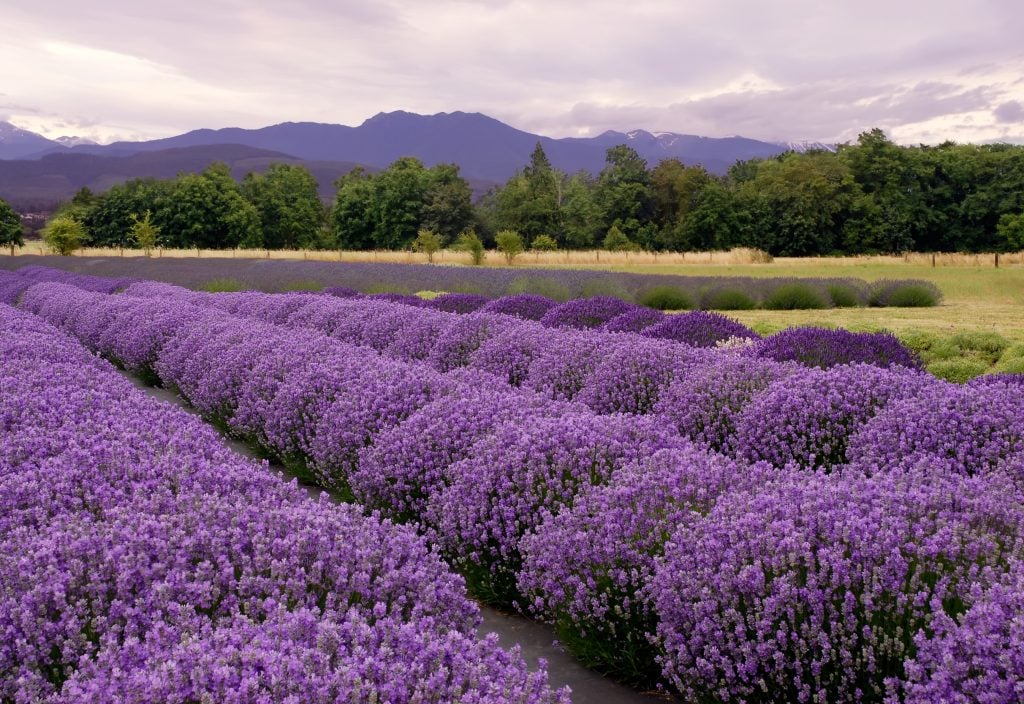
You can earn as much as $120,000 per acre in ideal conditions by selling fresh or dried lavender. And you can earn even more by creating your own value-added lavender products like soaps or lotions.
The great thing about lavender is that you can grow it for a profit on nearly any scale.
On the smallest scale, even backyard gardeners can plant a couple dozen lavender plants and generate a few hundred dollars per season.
Check out 21 Of The Best Small Scale Farm Ideas for more creative ways to grow profitable plants in small spaces.
Larger farms specializing in lavender can make hundreds of thousands of dollars per year or more. Purple Haze Farms in Washington produces over a million dollars of lavender per year on seven acres.
Bunches of fresh lavender at your local farmer’s market can easily sell for $5 each or more. For those that you don’t manage to sell, dry them and sell them to florists or crafters for use in arrangements.
If you are willing to produce your own line of lavender-scented soaps or lotions, you can multiply the profits of your lavender by four or five times.
Agrotourism is another potential source of income. People love to tour and take pictures in the rows of deep purple flowers.
When it comes to growing lavender, what you get out is in proportion to the effort you’re willing to put in.
In one acre, you can plant about 30 rows of 80 plants. You’ll get about $10,000 worth of fresh or dried lavender in an average year. A peak harvest will yield about $30,000 per acre. However, as previously mentioned, you can use your lavender to create other products and further maximize profit instead of selling the plant material directly.
How to Cultivate Lavender
If all of those numbers have you ready to invest in lavender, there are some other questions that you need to ask.
For example, how long does it take to grow lavender?
You shouldn’t expect the kinds of yields we’ve described above in your first year. It takes about three years to go from a four-inch cutting to your first full harvest. Growing lavender for profit is a long-term undertaking.
You will get your peak harvest when plants are approximately five years old. A lavender plant will yield for about eight to 10 years in total before needing to be replaced.
Soil Preparation
You’ll only want to start farming lavender if you already have sandy or loam soil.
Trying to amend a heavy clay soil won’t be financially viable. You would need a dozen or more dump trucks full of sand to achieve the necessary levels of drainage.
So if you’re set on growing lavender, you may need to relocate to somewhere that has the correct soil type.
Aim for a soil pH between 6.5 and 7.5. Lavender prefers a soil that is neutral or slightly alkaline.
Avoid using organic mulch since lavender is susceptible to fungus and mold. Black landscape fabric is the weed barrier of choice.
Since lavender is drought tolerant, you only need to water the soil every two or three weeks.
Propagation
Lavender is difficult to grow from seed. There’s also no guarantee that plants grown from seed will have the same characteristics as their parent plants.
For that reason, nearly all commercial lavender producers buy seedlings or grow cuttings from their existing plants. Using cuttings will ensure that plants are exact clones and that you’ll get a consistent level of oil production and flower color.
Cuttings are normally taken at harvest time when plants are already being trimmed back. They are typically placed in a mixture of 50/50 sandy soil and perlite and allowed to root then planted directly into the field.
Spacing
Lavender plants grow into large bushes. You may need between two and four feet between plants and three to six feet between rows. Some varieties grow larger than others, so there is some variation.
Harvesting
Since lavender can have problems with mold, it’s best to harvest it when it’s already as dry as possible. That means you should never harvest after rain or even a heavy dew. However, it’s a balance, as hot weather can also lead to oil loss.
The best time of day to harvest lavender is late morning or early afternoon.
For either fresh or dried flowers, you want to harvest just as the first flower blooms begin to open up.
For all other purposes, lavender is typically harvested in mid-June to late July in most locations. Oil can be collected for up to a month after bloom.
Harvesting lavender is one of the most labor-intensive parts of the growing process aside from weeding.
Most harvesting is done by hand using pruning equipment. Due to the cost, purchasing specialized harvest equipment usually isn’t justified unless you’re growing several hectares of lavender.
How to Dry Lavender
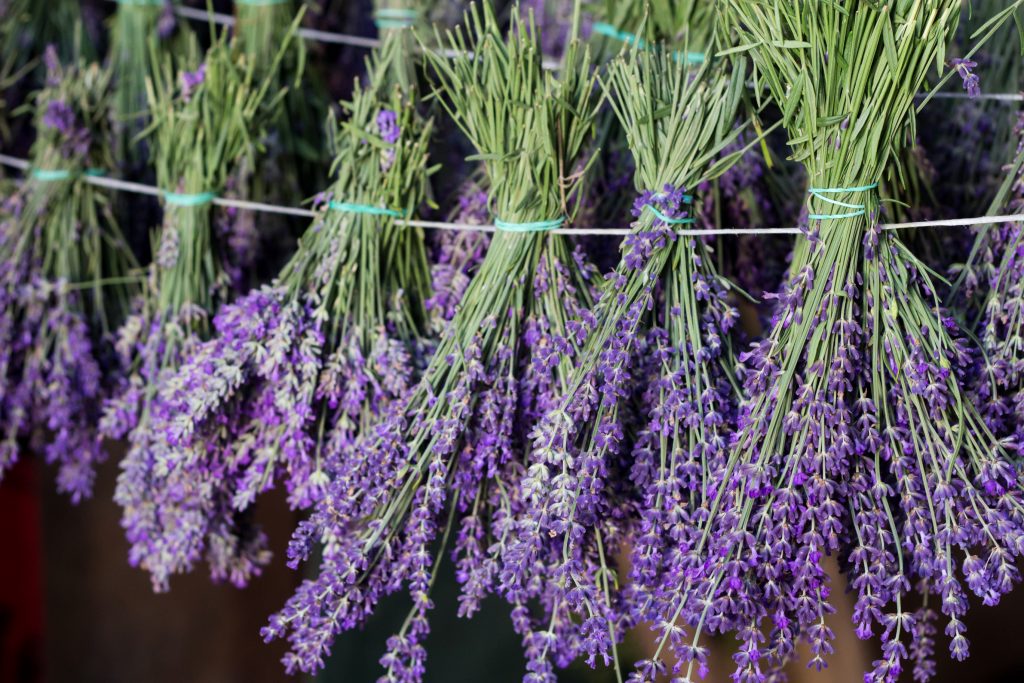
After harvest, lavender is grouped into bunches and the stems are bound together with rubber bands. Aim for bunches of stems around two centimeters in diameter for optimal drying.
These bunches are then hung upside down to dry. They should be kept in a dry, dark area with good ventilation to minimize the risk of mold growth.
Where to Sell Lavender
To maximize your lavender profits, you’ll want to try to sell the majority of your produce directly. That way you can cut out wholesalers or other retailers and get the best price for your lavender.
A farmer’s market on the weekend is a great place to sell your lavender in various forms. Bring a mixture of fresh cut lavender, dried bouquets, lavender oil and other products.
If your farm is in a location that gets a fair amount of traffic, you can also set up your own roadside farm stand. Operating on an honor system where people help themselves to your product and leave money in a lockbox minimizes the amount of labor required.
Lavender farms with a strong agrotourism aspect to their business may even want to set up a dedicated shop.
Any excess lavender that you can’t sell on your own may be sold to chefs, wholesalers, independent flower shops or other businesses.
For more information on growing and selling plants, check out our guide: Starting a Market Garden.
Products That Can Be Made From Lavender
Raw lavender is a profitable crop to grow all on its own. But it bears repeating that creating your own line of lavender products can really take your income to the next level.
There are dozens of different lavender products to consider. Most of them are easy to make and don’t require much setup or expensive equipment.
Focus your marketing and branding on the stress-relieving benefits of lavender’s scent.
Lavender soap is always a favorite of customers. It’s easy to get started with a basic soap recipe and some molds to pour your soap into. Aside from its calming smell, lavender also has natural antiseptic and antibiotic properties.
Even easier than soap, you can create potpourri or lavender sachets from dried lavender buds. Use the lavender on its own or mixed with other ingredients.
Lavender oil is one of the most sought after iterations of the plant. Aromatherapy is becoming more and more popular with no apparent end in sight! You will need to buy some distillation equipment to produce your own oil. It may cost you around $1,000 for a commercial distiller. Once you have one though, the process is quite straightforward.
Choose from cosmetic products, perfumes, lotions, massage oils and a lot more. Your imagination is the limit for what you can transform your raw lavender harvest into.
If you’re growing lavender anyway, you may also want to pair it with beekeeping. Lavender honey is a premium product and it’s unlikely you’ll have much local competition.
Final Thoughts
Growing lavender for profit is something we think all farmers or gardeners should consider.
If you live in an area with the right climate and soil conditions, lavender can be a very lucrative crop to grow.
You may want to make growing lavender your primary focus. However, you can also use it as a companion plant with other crops. You can use lavender plants as a hedge, to attract beneficial insects or simply as a way of diversifying your income.
Now that you know all about lavender and what it takes to grow it, you should have a good idea if it would make a good addition to your farm.
For more ways to make money with your land, check out our 48 ways to make money homesteading.
